Meat reducers rejoice! Christmas is perhaps the only remaining occasion when we can indulge an atavistic lust for huge hunks of flesh without an accompanying saucing of guilt – after all, you can't begrudge tradition. Three vegetarian days a week, 51 weeks a year equals, if you're lucky enough to be able to be able to afford it, one enormous turkey, a side of salmon and, to top it all off, king of the feast, a great pink ham sitting in pomp on the sideboard for all to admire.
This last is, naturally, always surplus to requirements given the 6kg of cold poultry sitting in the fridge alongside the pork pie and the cold chipolatas, but as one of the tastier of the season's many pointless traditions, it's well worth honouring as long as you commit to doing it justice. Buy the best pork you can afford (organic, free-range or outdoor reared), and cook it yourself, and you'll have leftovers worth pigging out on.
Thankfully, and unlike turkey, which needs to be curried or fricasseed or stuffed into sandwiches before the year has run its course, ham is the gift that will keep on giving well into the new one. Even if you can't run to the medieval magnificence of whole leg, a smaller ham will still feed a good crowd. And when it's finally done – well, back to those vegetables for another year.
The ham
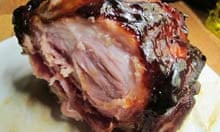
If you're really organised, of course, you can start with fresh pork and brine it yourself – Hugh Fearnley-Whittingstall has some useful advice on this subject. You'll need to do this a good few days in advance. More usual these days is to start with ready-cured pork, otherwise known as gammon (strictly speaking, a ham is a whole leg, while a gammon is a piece cut from a cured leg) and cook it at home.
Older recipes tend to tell you to soak gammon for a day or so to remove excess saltiness, but this is rarely necessary now. Do check the packaging, or ask your butcher however, just in case. You can use smoked gammon for ham, but I find it's easy for the flavour of the smoke to obscure that of the meat, so I've stuck with green, dry-cured gammon.
The cooking

Gammon is cured, but not cooked, so you'll need to either poach it or bake it before adding the glaze. Delia Smith goes down the baking route, shrouding the joint in a tent of foil, then popping it in a medium oven, as does Jennifer McLagan, author of Cooking on the Bone.
Unlike Smith, however, she bakes hers in a rack set above a pan of stock – pork or court bouillon – and leaves it uncovered. I'm surprised to find that there isn't a great difference in texture between these baked hams and those poached in a large pan of water (I expected them to be dryer) but, with the exception of Thane Prince, who adds nothing to the poaching liquid, the latter group has a more interesting flavour. Poaching, I conclude, seems to be a more effective way of infusing flavour than steaming.
Ham can be cooked in just about any liquid: I find recipes using cider (Porters Seasonal Celebration Cookbook), spiced wine (Richard Corrigan) and orange juice, but I can't resist Nigella Lawson's Coca-Cola number, an idea borrowed from the American south, where they like their food sweet and sticky.
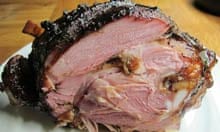
When I think about it, it's actually not too different to that used by Jane Grigson in her Bradenham ham recipe, which cooks the traditional cure black ham in a mixture of water, molasses and pickling spices, but I prefer the latter. I'm not a great fan of cola, and its citric flavour comes through in Lawson's ham, along with a rather more attractive sugariness. Far more to my taste is the treacly, spicy flavour of Grigson's joint, which puts me in mind of Christmas gingerbread and other good things. She's silent about her particular pickling mixture, so I'm going with an appropriately festive mix of sweet allspice and cloves and peppery mace, in addition to the standard bay leaf and black peppercorns.
Another bonus is that both Lawson's and Grigson's hams look strikingly dark, which, even with the skin removed, makes a nice contrast to the pink inner meat. A Christmas ham ought to be decorative as well as delicious.
The glazing
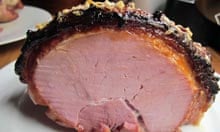
What sets a Christmas ham apart from any common or garden gammon is the glaze – the icing on the piggy cake as far as I'm concerned. This should not only taste good, but look festive too. Grigson outlines the basics in English Food, saying that "the thing is to have a basic mixture of mustard and sweetness" – in her case, French mustard and brown sugar, redcurrant jelly or marmalade, plus double cream and cinnamon or cloves. Smith has clearly been issued with the same carol sheet, smothering her ham with English mustard and topping it with demerara sugar.
Prince disagrees – in Ham, Pickles and Jam, she offers three options for a sticky glazed ham, only one of which involves mustard. The second, which I decide to try, replaces the mustard powder with plain flour and uses soft brown sugar and either sherry or orange juice. The guiding principle seems to be to ensure there's something dry in the topping, whether that's flour or mustard powder, so it forms a thick paste and doesn't simply slide off the joint as it heats like McLagan's port, honey and sugar mixture.
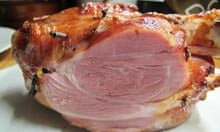
Prince's sugary, floury glaze (which I put on Grigson's ham by mistake) gives the best result: a crunchy, solid crust with a lovely sweetness to it. But I miss the heat of the mustard, so I decide to adopt the same principle, making a thick paste, but using mustard powder instead of flour. Adding breadcrumbs, as Grigson suggests, does provide temporary crunch, but they quickly go soggy when the ham cools, so I'm steering clear on this occasion.
There are several options for the sweet element of proceedings: I find Lawson's treacle rather bitter after heating and McLagan's honey too subtle, so dark brown sugar seems the ideal compromise. Instead of Grigson's marmalade, which I like but fear will loosen the mixture, I'm adding orange zest for a festive hint of citrus. The mixture does need some liquid, of course, and Prince's sherry worked pretty well, but really, what could be more Christmassy than my old favourite, ginger wine, which combines spice and booze in one glorious package?
Temperature-wise, a shortish blast in hot oven, as Lawson and Smith suggest, works better for crisping than Grigson's slower cooking at a more moderate heat. Smith's mustard and brown sugar glazed ham looks lovely – a vibrant yellow colour – and although it's not quite Christmassy enough for my taste, I find that sprinkling on a little extra sugar once the glaze is on, as she does with her mustard, gives a more even caramelisation.
Perfect Christmas ham
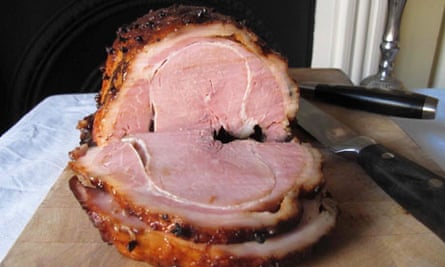
Rich, dark and spicy sweet, this is a ham which should carry on bringing festive cheer long after the big day is over.
Serves 8
1 boneless gammon joint, about 2kg
3 tbsp molasses or black treacle
1 tsp cloves
Pinch of mace
1 bay leaf
1 tsp allspice
1 tbsp black peppercorns
Peel of ½ an orange, cut into thin strips
Handful of cloves
For the glaze:
5 tbsp dark brown sugar, plus extra to sprinkle
1½ tbsp mustard powder
Finely grated zest of ½ orange
20ml ginger wine
1. Put the ham in a large stock pot, and cover with cold water. Add the molasses, spices and orange peel and bring slowly to a simmer, skimming off any scum. Simmer very gently for about an hour and a half, until the internal temperature of the ham reaches 68C.
2. Heat the oven to 220C. Lift the ham out of the liquid (which can be used to make delicious baked beans), allow to cool slightly, then carefully cut off the skin, leaving as much fat beneath as possible. Score this in a diamond pattern, and stud the intersections with cloves. Put the ham in a foil-lined roasting tray.
3. Mix together the glaze ingredients into a thick paste, and brush this all over the fat. Put into the hot oven for about 25 minutes, basting twice during this time, and adding a sprinkle more sugar as you go, until the glaze is caramelised and bubbling. Allow to cool completely before serving.
If you follow the tradition of cooking a Christmas ham, how do you do yours? Is there any better way of using up the leftovers than a doorstop sandwich with a good dollop of mustard – and if you don't do ham, tell us, what does keep you going until real life resumes in January?
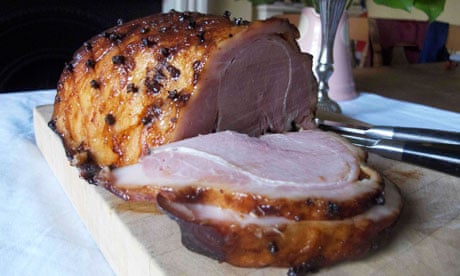
Comments (…)
Sign in or create your Guardian account to join the discussion